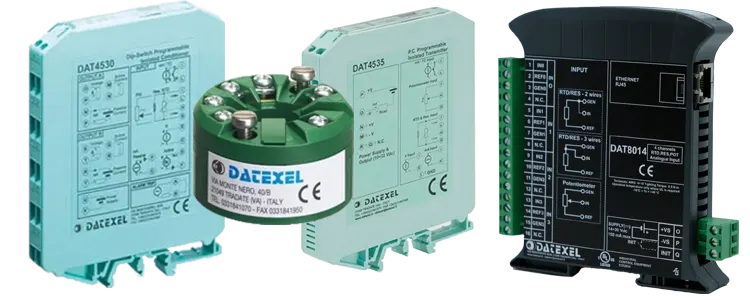Datexel Blog
Also Questions and Answers


Choosing the correct temperature transmitter can be difficult, and it may be best to consult a specialist. After choosing which temperature sensor to use, you have to decide on the mounting of the temperature transmitter, and three options come to mind. Read on for a simple guide to types of temperature transmitters.
Are you considering Modbus for your data acquisition needs but are unsure what setup to use? We have the answers you’re looking for, so read on.
Modbus data acquisition systems are essential tools for monitoring and controlling industrial processes. Find out the reasons to use these systems.
Modbus RTU and Modbus TCP are both communication protocols used in industrial automation. However, some critical differences between the two can influence your decision about which one to use. This article will explore the differences between Modbus RTUs and Modbus TCPs to help you decide which protocol is best for your application.
Understanding the difference between a Modbus Master and a Modbus Slave is essential for anyone working with industrial automation systems. These two roles define how data is requested, transmitted, and controlled within a Modbus RTU network. In this article, we’ll explore what each role means, how they interact, and why this master-slave communication model remains a fundamental part of many industrial applications today.
Signal conditioning covers any signal that fundamentally changes to another type of signal. This topic only considers industrial instrumentation signal conditioning. Read on to discover what you need to know about signal conditioning, from two-wire signal transmitters to frequency converters.
Which signal splitter do you need for your facility? Keep reading to learn how to choose between 4-20mA, RTD, and thermocouple signal splitters.
Unsure of the difference between temperature transmitters and sensors? This post breaks it down for you by explaining the benefits of each and how they work.
If you’re looking for a way to simplify your process and improve your signal quality, using a 4-20mA signal splitter might be the answer to your problems.
If you need loop-powered, the best option would be the DAT4535, and if you need power, the best option would be the DAT4235. Datexel has another device that may be more cost-effective, and the DAT4532D is a powered dual signal conditioner.
DAT4535 DAT4235 DAT4532DThe DAT2045 is a low-cost thermocouple transmitter, and the DAT2105-2W is an RTD transmitter; these devices are non-isolated. The DAT2045 can be set up with DIP switches and zero and span potentiometers on the front panel. The DAT2105-2W is PC programmable with the option for zero and span potentiometers on the front panel.
DAT2045 DAT2105-2WThe DAT4535 is a two-wire signal transmitter that can accept thermocouples and RTD and convert it to a two-wire 4-02mA output.
DAT4535The DAT1010 is a low cost RTD temperature transmitter, and the DAT1015 is an RTD and thermocouple transmitter, both these devices are non-isolated. The DAT1010 and DAT1015 are PC programmable.
DAT1010 DAT1015The DAT1061 is an Isolated RTD head-mounted temperature transmitter. The DAT1066 is an isolated thermocouple and RTD head-mounted temperature transmitter. Both are loop powered.
DAT1061 DAT1066The DAT4235 can accept a 1-5 Vdc input and convert it to a 0-10Vdc output. It can accept any standard analog input and provide a 0-10Vdc or 4-20mA output. The DAT4535D is a dual converter that can take Voltage and correct inputs and provide current and voltage outputs.
DAT4235 DAT4532DThe DAT4535 can do all the functions that the DAT4035 can. The new feature that the DAT4535 has over the DAT4035 is the ability to program the DAT4535 while no power is connected, enabling fast configuration. Also, the DAT4535 is DIP switch configurable.
DAT4535The DAT4235 replaced the DAT4135 and is able to perform the same functions and has more features. The new features that the DAT4235 has over the DAT4135 is the ability to program the DAT4235 whilst no power is connected enabling fast configuration.
DAT4235The DAT1066 also has the ability to be configured without a power supply connected. The DAT1066 provides 1500 Vac isolation. The DAT1066 can convert and isolate thermocouples and RTD's.
DAT1066